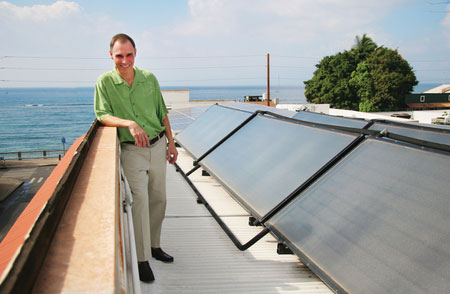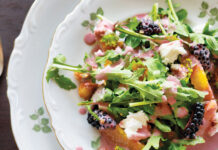Story by Shannon Wianecki | Photography Nina Lee
Lahaina Grill

This classy West Side dining spot is known for award-winning cuisine—the mouthwatering duck and signature triple-berry pie have garnered praise from reviewers nationwide. Less well known, however, is the restaurant’s pioneering role in energy efficiency on Maui.
Jurg Munch is a conscientious restaurateur; he lavishes personal attention on guests dining at Lahaina Grill, treats his staff generously, and fastidiously attends to details others tend to overlook. Recently, his dedication to doing things right took shape in an impressive “green and clean” retrofitting of his restaurant and inn.
“I decided to take an active lead and convert the building as much as we could to green energy,” says Munch.
He began by replacing a faulty air conditioner, and one thing led to another. Three years later, the historic building at 127 Lahainaluna Road has cut its energy draw by a third.
The sophisticated new air-conditioning system knows which rooms to cool at which times of day and cycles off for maximum efficiency. Heat generated as a byproduct of the cooling system is funneled into an exchanger and transformed into an average of 280 gallons of useable hot water every eight hours. This is in addition to a new solar water heater, which also heats up on demand.
Lahaina Grill’s to-go containers, straws, and trash bags are now fully biodegradable, as are the cleaning products used throughout the restaurant. Old incandescent and fluorescent bulbs were swapped out for energy-rated light fixtures.
Gathering all these green restaurant supplies was no easy feat, says Munch, because “there is no wholesale green company. It took us almost a year just to find these products.”
Munch’s biggest leap into the green was a $100,000 investment in photovoltaic panels.

“When you walk through Lahaina, you just feel the heat,” says the Swiss-born restaurateur, gesturing towards the midday sun. “What a waste if you couldn’t make use of it.”
The rooftop photovoltaic panels capture enough sunlight to meet a hefty portion of the restaurant and inn’s energy needs—renewably. And by slashing Munch’s monthly electric bill, the system will pay for itself in a few years.
“Once it is up and running, it’s relatively maintenance-free,” says Munch. “You just need to clean the panels.”
That may be so, but Munch did encounter considerable obstacles in getting his eco-friendly systems operational. Dust, leaves, and bird droppings reduce the solar panels’ efficiency; washing them necessitated a rooftop water system and gutters. A massive tree that blocked the afternoon sun had to be removed, at a cost of $10,000. Additionally, the fancy new air-conditioning unit required new cabinetry—and an extension of the building. Munch forged ahead, even though the renovations meant closing his busy restaurant for two weeks.
“Every step of the way, any other commercial client would have stopped,” says Lahaina Grill publicist Alyson Freeland.
Undeterred by the challenges, Munch converted his employees into believers—including Freeland, who was so impressed by the solar panels’ outputs that she’s investing in some herself. The tax breaks are considerable, says Freeland, and, “on a sunny day, the meter goes backwards.”
Next on Munch’s list: replacing toilets and showerheads with models that conserve water. “Every piece of equipment we buy we totally research to make sure it’s efficient,” he says.
“It feels great,” says Munch. “Just the fact that we’re over 30 percent self-sustaining. . . . It feels good to be contributing to the environment here.” He hopes his efforts inspire other restaurant owners. “You really just have to look at the big picture and see the reward at the end of the tunnel.”
Many satisfied guests at Lahaina Grill can attest that the reward is truly one to savor.
Merriman’s Kapalua

Renowned Chef Peter Merriman’s email signature reads “Locovores since 1988.” Long before it was fashionable, this founding member of the Hawai‘i Regional Cuisine movement prided himself on sourcing vegetables and meats for his Big Island restaurant within a 100-mile radius, more or less. He recycled boxes and composted food scraps. Two decades and a few restaurants later, the industry is finally catching up.
“So many of the things we were innovators on are now required,” says Merriman. “We’ve been recycling for twenty years; now it’s the law.” He smiles. “It’s good they’re finally coming around.”
Since opening his Kapalua restaurant last year, the chef has cultivated relationships with Maui farmers. His favorite local products include Maui Cattle Company beef, Haleakala Ranch lamb, Olinda asparagus, and Kapalua pineapples. “Of course we like organic,” says Merriman. “But the most important thing to us is not organic, it’s sustainability.”
Sticking to sustainable, local sources has its challenges. On Maui, it can mean forgoing some favored menu items, such as stone fruits and other cold-weather crops that aren’t abundant here. “I’d like to see more potatoes,” says Merriman. “Those that are grown here are fantastic. I’d also like to see more dairy. Na‘alehu butter [from the Big Island] is the best butter in the world. The dairy industry is in a world of hurt; it might not survive in Hawai‘i.”
Preventing such an industry collapse is a chief motivation for buying local—that and the inarguable fact that fresher produce tastes better. “I feel a personal responsibility,” says Merriman. “I’ve made my living off of what Hawai‘i grows, so I owe something in return.”
Merriman was an early proponent of the local bottom-fish ban. “Fish sustainability is a really big issue that we don’t have figured out. A lot of diners in the U.S. expect when they order fish it will be eight ounces. That’s a lot of fish. That’s more than you need nutritionally, and it’s having a really big impact on the resource,” he says. “I think it’s the responsibility of the chefs over the next few years to educate diners to be satisfied with a smaller cut of fish.”
Merriman handles the dilemma at his restaurants by mixing wild caught and farmed fish, and by serving smaller portions of seafood—a few locally farmed shrimp, for example—alongside beef.

“We’re big supporters of the ranchers,” he says, “because if you can keep ranching viable, you can keep green space in Hawai‘i.
Ever the innovator, Merriman recently took the recycling effort into his own hands. Order bottled water at Merriman’s Kapalua or Waimea restaurants, and your server will return with a bottle of “Petergreeno.” Merriman’s eponymous aqua is collected from the atmosphere right here in Hawai‘i, sent through a reverse osmosis filtration system, and bottled in attractive, reusable glass bottles. Empty bottles are returned to the kitchen, where they are sterilized, refilled, and sealed. “Nothing goes to the landfill,” says Merriman. “Which I think is huge.”
“We can’t be the solution to everything, but when possible, we can help people understand that [sustainable dining] can be just as much fun and they can enjoy it just as much.”
As these restaurants’ policies become the rule rather than the exception, Maui diners can look forward to enjoying bountiful harvests long into the future.





